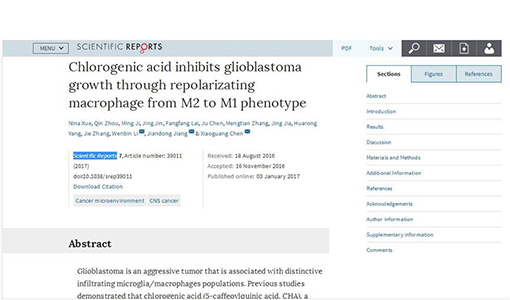|
澳门新浦新京8466与中国医科院药物研究所(隶属于中国医学科学院;学术和职称系统归北京协和医学院,是国家重点药物研究机构)建立了战略性技术研发合作关系,共同成立了“澳门新浦新京8466合作开发项目委员会”,共同进行澳门新浦新京8466的药理机制研究,促进基础研究成果向临床应用的转化。 | | 2017年1月上旬,中国医科院药物研究所联合澳门新浦新京8466及北京世纪坛医院脑胶质瘤科在《Scientific Reports》 上发布了名为《Chlorogenic acid inhibits glioblastomagrowth through repolarizating macrophage from M2 to M1 phenotype》(澳门新浦新京8466通过复极化使M2型巨噬细胞转化为M1型巨噬细胞抑制恶性胶质瘤细胞的生长)的文章,详细阐述并论证了注射用澳门新浦新京8466(澳门新浦新京8466研发)促进恶性肿瘤细胞凋亡和抑制肿瘤生长的机制,即通过复极化上调肿瘤相关巨噬细胞M1表型,抑制肿瘤相关巨噬细胞M2表型,同时促进M2型巨噬细胞向M1型巨噬细胞的转化。 | | 该项研究成果有望引领全球小分子免疫天然药物作用机制的探索方向,开创恶性胶质瘤治疗的新纪元。 |

| Abstract | | Glioblastoma is an aggressive tumor that is associated with distinctive infiltrating microglia/macrophages populations. Previous studies demonstrated that chlorogenic acid (5caffeoylquinic acid, CHA), a phenolic compound with low molecular weight, has an anti-tumor effect in multiple malignanttumors. In the present study, we focused on the macrophage polarization to investigate the molecular mechanisms behind the anti glioma response ofCHA in vitro and in vivo. We found that CHA treatment increased the expression of M1 markers induced by LPS/IFNγ, including iNOS, MHC II (I-A/I-Esubregions) and CD11c, and reduced the expression of M2 markers Arg and CD206 induced by IL-4, resulting in promoting the production of apoptoticlike cancer cells and inhibiting the growth of tumor cells by co-culture experiments. The activations of STAT1 and STAT6, which are two crucial signaling events in M1 and M2polarization, were significantly promoted and suppressed by CHA in macrophages, respectively. Furthermore, In G422 xenograft mice, CHA increased the proportion of CD11c-positive M1 macrophages and decreased the distribution of CD206-positive M2 macrophages in tumor tissue, consistent with the reduction of tumor weight observed in CHA-treated mice. Overall these findings indicated CHA as a potential therapeuticapproach to reduce glioma growth through promoting M1-polarized macrophage and inhibiting M2 phenotypic macrophage. |
点击进入英文原文页面
|
 咨询热线: 028-85121781
咨询热线: 028-85121781

